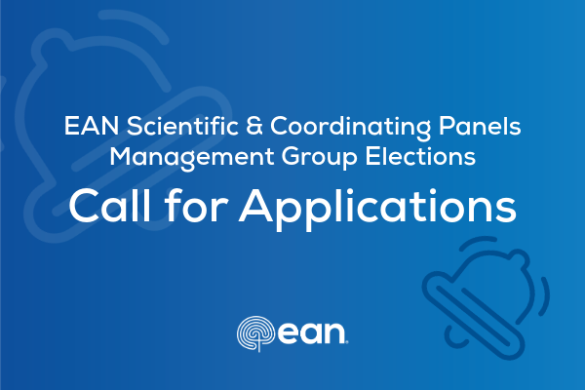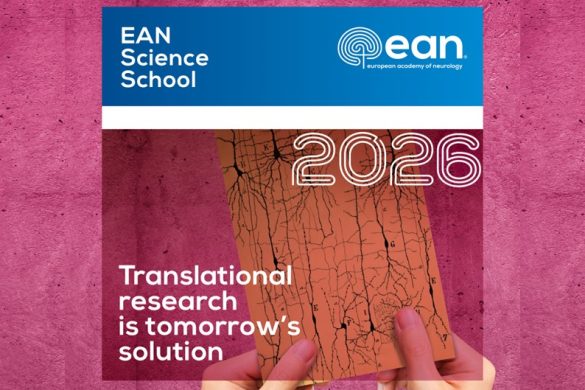by Clauda Santos Silva, EAN Scientific Committee
As part of the EAN Scientific Committee’s liaison with the European Medicines Agency (EMA), we reviewed the 2024 EMA Annual Report to identify developments of relevance to the field of neurology. Below is a comprehensive summary of the most important regulatory milestones, pharmacovigilance updates, and innovation initiatives pertinent to the neurology community. Please see the full version of the 2024 EMA Annual Report here: Homepage | EMA annual report 2024
New Medicines and Indications
- Qalsody (tofersen) for SOD1-ALS: a major milestone in 2024 was the EMA’s recommendation to grant marketing authorisation under exceptional circumstances for Qalsody (tofersen), developed by Biogen, for the treatment of adults with amyotrophic lateral sclerosis (ALS) linked to mutations in the SOD1 gene, which account to 2% of ALS cases are caused by SOD1 mutations. Qalsody is an antisense oligonucleotide that binds to SOD1 mRNA to reduce production of the defective protein, thereby slowing neurodegeneration.
- Leqembi (lecanemab) for Early Alzheimer’s Disease: another key development was the approval of Leqembi (lecanemab), a humanised monoclonal antibody developed by Eisai and Biogen, for the treatment of early Alzheimer’s disease. Targeting aggregated amyloid-β, lecanemab has been shown to reduce amyloid plaque accumulation and slow disease progression in patients with mild cognitive impairment or mild dementia, particularly those carrying ApoE4 genotypes.
- Wainzua (eplontersen) for ATTRv Polyneuropathy: a further important recommendation for approval was made for Wainzua (eplontersen), a self-administered subcutaneous antisense oligonucleotide co-developed by AstraZeneca and Ionis Pharmaceuticals. It is indicated for adult patients with hereditary transthyretin-mediated amyloidosis (ATTRv) with stage 1 or 2 polyneuropathy. Eplontersen reduces hepatic production of transthyretin (TTR), thereby limiting amyloid deposits in peripheral nerves.
- Dimethyl Fumarate (Generics) for Relapsing MS: the EMA also approved generic formulations of dimethyl fumarate by companies including Accord Healthcare, Mylan, and Neuraxpharm. These generics expand access to an established disease-modifying therapy for relapsing multiple sclerosis. Dimethyl fumarate activates the Nrf2 pathway, helping to counteract oxidative stress and inflammation within the central nervous system.
- Kizfizo (dinutuximab beta) for Neuroblastoma: the EMA also approved Kizfizo, a monoclonal antibody used in the treatment of neuroblastoma, a rare cancer originating from immature nerve cells.
Negative CHMP Opinions Relevant to Neurology
- Masitinib (AB Science) for ALS: Masitinib, a tyrosine kinase inhibitor developed by AB Science, was evaluated as an add-on oral treatment for ALS, in combination with riluzole. Despite its proposed neuroprotective effects through inhibition of microglial activation, the CHMP adopted a negative opinion in June 2024. This was due to inconclusive efficacy data, protocol deviations in clinical trials, and an unclear benefit-risk balance. A re-examination confirmed the refusal later in the year.
- Nezglyal (leriglitazone) for Cerebral Adrenoleukodystrophy (cALD): Nezglyal, developed for the treatment of cerebral adrenoleukodystrophy, acts as a PPARγ agonist aimed at modulating inflammation and oxidative stress. The CHMP issued a negative opinion in May 2024, citing insufficient evidence of efficacy and the lack of correlation between biomarker changes and clinical outcomes. The request for re-examination was also declined.
Changes in Orphan Designation Status
- Notably, by the end of 2024, a total of 15 medicines had their orphan designation confirmed. Among those relevant to neurology was Qalsody (tofersen). In contrast, six medicines lost their orphan status prior to authorisation, including Wainzua (eplotersen).
Pharmacovigilance and Safety Updates
- Valproate – Reproductive Risk in Men: the EMA issued new precautionary measures for valproate, expanding warnings to include potential neurodevelopmental risks in offspring of male patients treated with the drug. This reinforces the need for careful use in reproductive-age populations.
- Fluoroquinolones – Neuropsychiatric Effects: updated warnings for fluoroquinolones highlighted neuropsychiatric side effects such as anxiety, neuralgia, and suicidal ideation.
- CAR-T Cell Therapies – Secondary Malignancies: long-term monitoring was advised for patients treated with CAR-T cell therapies due to the risk of secondary malignancies.
- Oxycodone: Dependence and Addiction: a new black-box warning was introduced for oxycodone, underscoring the risk of dependence and addiction.
- Reyataz (atazanavir) – New contraindications: Reyataz, an antiretroviral used in the treatment of human immunodeficiency virus (HIV-1) infection, received updated contraindications from EMA in 2024. Co-administration with the anticancer agents encorafenib and ivosidenib, as well as with the anticonvulsants carbamazepine, phenobarbital, and phenytoin, is now contraindicated due to the risk of serious drug interactions.
- Medroxyprogesterone Acetate – Meningioma Risk: new measures were introduced to minimise the risk of meningioma, in patients taking medroxyprogesterone acetate. The EMA now recommends avoiding its use in patients with a current or past history of meningioma unless it is indicated for cancer treatment. High-dose users should be monitored for symptoms of meningioma.
- Mysimba (naltrexone/bupropion) – Opioid Interaction Risk: the EMA strengthened existing guidance to minimise the risk of interactions between Mysimba and opioid-containing medicines. These include morphine, codeine, opioids used perioperatively, and some medications for cough, cold, or diarrhoea. Clinicians are advised to screen for opioid use and adjust treatment accordingly.
Scientific and Regulatory Innovation
- DARWIN EU – Real-World Evidence Network: the EMA made significant strides in the use of real-world data and digital innovation in 2024. The DARWIN EU® (Data Analysis and Real-World Interrogation Network) became fully operational, now incorporating health data from over 160 million patients across 16 European countries. This network supports regulatory decisions with high-quality real-world evidence (RWE) on the safety, effectiveness, and utilisation of medicines.
- Artificial Intelligence and Scientific Explorer: the EMA also launched Scientific Explorer, an AI-powered tool designed to support regulators in analysing historical scientific advice. This is part of the broader AI Work Plan 2023–2028, which aims to enhance regulatory efficiency and safety. These innovations are particularly promising for the field of neurology, where heterogeneity and complexity often demand advanced data analysis and decision-support tools.
- Clinical Trials Reform – CTIS and ACT EU: finally, regulatory reform progressed through the full implementation of the Clinical Trials Information System (CTIS) and the expansion of the ACT EU initiative, enhancing the transparency, speed, and quality of clinical trial processes. With CTIS now recognised as a WHO Primary Registry, European neurology trials are expected to benefit from streamlined global registration and harmonisation.
Conclusion
The EMA’s 2024 activities reflect sustained progress in the regulation and support of innovative therapies for neurological disorders. From the first genetically targeted ALS treatment and Alzheimer’s disease-modifying therapies to improved MS treatment access and safety updates in common neurological drugs, the Agency’s work reinforces the importance of tailored regulatory approaches in neurology.
The EAN Scientific Committee will continue to monitor these developments and advocate for the integration of cutting-edge science into clinical neurology practice across Europe.









